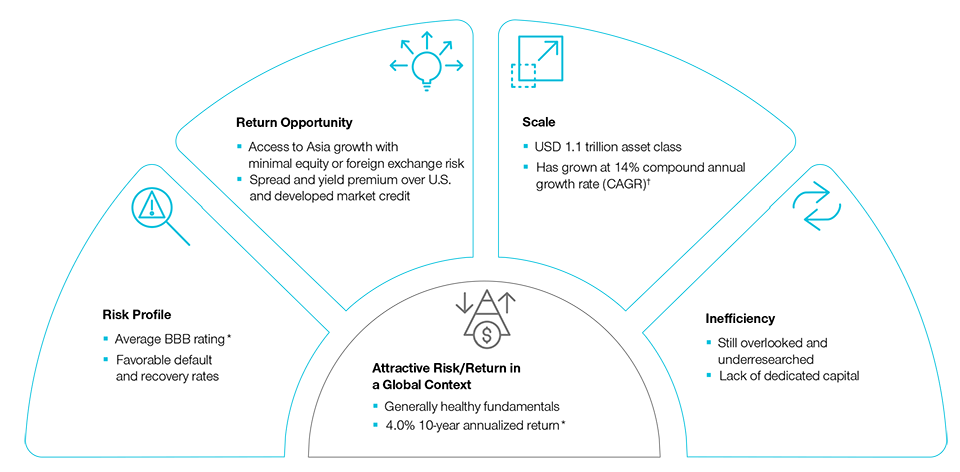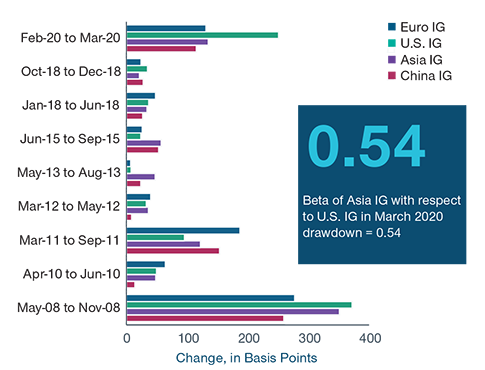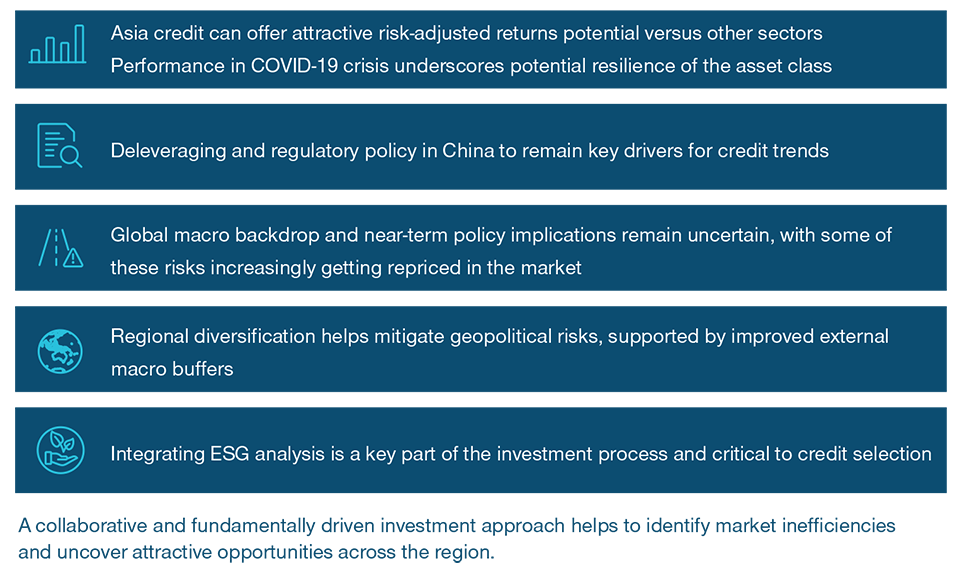June 2022 / FIXED INCOME
Analyzing the Case for Asia Credit Bonds
An attractive combination of risk and return.
Key Insights
- We view Asia credit bonds as a relatively new asset class with sound long-term prospects predicated on strong regional economic growth.
- Asian corporate bonds generally have held up well relative to their developed market peers in periods of global market volatility and widening investment-grade credit spreads.
- Many of our Asian credit exposures are from countries that have investment-grade credit ratings and stable or positive ratings trajectories in recent years.
Here we consider some of the key features of Asia credit bonds, defining the asset class as the universe of U.S. dollar or other hard currency denominated bonds of Asian issuers, both corporate and sovereign, but excluding Japan. We view Asia credit bonds as an exciting, relatively new asset class with sound long-term prospects predicated on strong regional economic growth. An allocation to Asian credit can act as a diversifier within global fixed income portfolios. When compared with regional equities, the corporate segment can also be thought of as providing a more defensive way for investors to access Asia’s high economic growth potential.
Advantages of Asia Credit Bonds
Scale: The first advantage of Asia credit bonds is that they possess significant scale, having grown into a universe that is too big for global bond investors to ignore. Today, the Asia credit bond market consists of around USD 1.1 trillion of outstanding bonds.1 In terms of size, this is roughly comparable to some of the more mainstream global fixed income sectors. For example, the U.S. high yield market—a segment often thought of as mainstream—is only a little larger, with some USD 1.5 trillion of bonds outstanding.1
The Asia credit opportunity today is broadly comparable in terms of magnitude to that offered by U.S. high yield. Importantly, we have reached today’s scale via healthy growth in the volumes of Asia credit over the past decade, where annual growth has averaged 14%.2 So this is a fixed income market that has experienced significant growth over time. This has led to a corresponding increase in the breadth and depth of the opportunities available to investors in Asia credit bonds.
Making the Case for Asia Credit Bonds
(Fig. 1) Key drivers of Asia credit investing

Past performance is not a reliable indicator of future performance.
As of March 31, 2022.
*Average credit rating and 10-year return are for the J.P. Morgan Asia Credit Index Diversified, as of March 31, 2022.
† Refers to the market capitalization of the J.P. Morgan Asia Credit Index Diversified, 10-years as of March 31, 2022.
Source: J.P. Morgan. Information has been obtained from sources believed to be reliable but J.P. Morgan does not warrant its completeness or accuracy. The index is used with permission. The Index may not be copied, used, or distributed without J.P. Morgan’s prior written approval. Copyright © 2022, J.P. Morgan Chase & Co. All rights reserved.
Return Potential: The second key advantage of Asia credit bonds concerns prospective returns. Currently, global investors receive a yield pickup that looks quite attractive versus U.S. and devoped credit markets, and also versus global aggregate benchmarks. The average yield to maturity for Asia credit bonds ( J.P. Morgan Asia Credit Index Diversified) is 4.8%, offering a spread of around 265 basis points over the corresponding yield on global bonds.3 At the same time, we view investors as gaining access to a region where there is still good long-run growth potential that over time can translate into improving credit profiles and lower spreads.
Risk: The third factor supporting Asia credit bonds concerns the risk profile. Out of the emerging market fixed income universe, our analysts characterize Asia credit as belonging to the higher-quality segment. The ratings profile is one feature that shows this higher-quality bias. Asia credit bonds have an average investment-grade (IG) rating, and almost 80% of the bonds in the universe are rated investment grade.4
Inefficiency: A fourth supportive factor is inefficiency. Within Asia credit there are informational asymmetries in the market. This can benefit active managers who can navigate these market inefficiencies and identify “alpha” with a process that is centered on fundamental credit and fixed income research. So, ultimately, we believe there is a compelling risk-adjusted potential return opportunity for Asia credit bonds within the overall global fixed income context.
One of the key selling points for Asia credit is that, historically, the asset class has generated attractive risk-adjusted returns. This is particularly true for the IG part of Asia credit, which is about 80% of the opportunity set. This attractive historical risk/reward combination can be seen clearly in Figure 2. Over the 10-year period to March 31, 2022, the Asia IG sector delivered a similar long-term return to U.S. investment grade, but it did so with less volatility.
Asia Credit Has Attractive Risk-Adjusted Returns
(Fig. 2) Asset class 10-year risk/return profile

Past performance is not a reliable indicator of future performance.
As of March 31, 2022.
International bonds: Bloomberg Global Aggregate Treasuries Index; U.S. Treasuries: Bloomberg U.S. Treasury Index; U.S. IG Corporate: Bloomberg U.S. IG Corp. IG Index; U.S. High Yield: Bloomberg U.S. High Yield; EM Sovereign Hard Currency: J.P. Morgan Emerging Market Global Diversified Bond Index; EM Corporates: J.P. Morgan CEMBI Broad Diversified; EM Sovereign Local Currency: J.P. Morgan GBI EM GD Index; Euro IG Corporate: Euro Corp. IG Corporates Index; Euro HY: Bloomberg Pan-European High Yield; JGB: Bloomberg Asian Pacific Japan; Bunds: Bloomberg Global Treasury Germany; Asia Credit: J.P. Morgan Asia Credit Diversified Index; Asia Credit IG: J.P. Morgan Asia Credit Index Diversified IG; Asia Credit High Yield: J.P. Morgan Asia Credit Index Diversified HY; EM Equity: MSCI Emerging Markets. This chart is shown for illustrative purposes only and does not represent the performance of any specific security, product or service. It is not possible to invest in an index. Sources: Bloomberg Index Services Limited, J.P. Morgan, T. Rowe Price.
To illustrate this point further, we looked at past periods of global market volatility where IG bond spreads around the world were widening (Figure 3). We found that Asian investment-grade bonds in these periods generally held up well against their developed market peers, widening less than or similar to U.S. and European investment-grade bonds. A good example is the sell-off that occurred during the peak of the coronavirus pandemic in 2020. Then, Asia IG spreads actually widened about half as much as U.S. investment-grade corporate bonds.
Asia IG Bonds Held Up Well in Turbulent Markets
(Fig. 3) Change in IG spreads over U.S. Treasuries by region*

Past performance is not a reliable indicator of future performance.
As of March 31, 2022.
*Figure 3 shows periods where spreads for either Asia IG or US IG widened by 35 basis points or more based on month-end levels.
International bonds: Bloomberg Global Aggregate Treasuries Index; U.S. Treasuries: Bloomberg U.S. Treasury Index; U.S. IG Corporate: Bloomberg U.S. IG Corp. IG Index; U.S. High Yield: Bloomberg U.S. High Yield; EM Sovereign Hard Currency: J.P. Morgan Emerging Market Global Diversified Bond Index; EM Corporates: J.P. Morgan CEMBI Broad Diversified; EM Sovereign Local Currency: J.P. Morgan GBI EM GD Index; Euro IG Corporate: Euro Corp. IG Corporates Index; Euro HY: Bloomberg Pan-European High Yield; JGB: Bloomberg Asian Pacific Japan; Bunds: Bloomberg Global Treasury Germany; Asia Credit: J.P. Morgan Asia Credit Diversified Index; Asia Credit IG: J.P. Morgan Asia Credit Index Diversified IG; Asia Credit High Yield: J.P. Morgan Asia Credit Index Diversified HY; EM Equity: MSCI Emerging Markets. This chart is shown for illustrative purposes only and does not represent the performance of any specific security, product or service. It is not possible to invest in an index. Sources: Bloomberg Index Services Limited, J.P. Morgan, T. Rowe Price.
To summarize, the Asian credit asset class has provided a spread pickup over U.S. IG bonds; in periods of global market turbulence it has behaved in a fairly similar manner, though with less duration and interest rate sensitivity. We think this is an interesting combination to consider adding for global fixed income portfolios.
Asia Credit Bonds and Responsible Investing
Environmental, social, and governance (ESG) considerations are an important part of our approach to investing in Asian credit. This is increasingly important to investors around the world. The ESG dimension is particularly critical in terms of achieving investment success in Asia. At T. Rowe Price, we believe that integrating ESG into our process can help us to build more resilient Asian bond portfolios.
Asia Credit Bonds
(Fig. 4) Current key investment themes

Source: T. Rowe Price.
This material is not intended to be investment advice or a recommendation to take any particular investment action.
On the environmental side, Asia is quite clearly starting the race from the back of the starting grid. We carried out a study of global fixed income benchmarks and found that Asia credit has the highest carbon intensity. This is partly a function of high growth and high energy intensity, accompanied by above-average reliance on fossil fuels such as coal. In Asia, bond issues tend to be skewed toward more commodity-and energy-intensive industries. On the positive side, we are seeing a stronger response among the companies we monitor to the market’s demand for progress on environmental initiatives, as well as better disclosure. As an example, more of the companies within our portfolio are reporting their carbon data today compared to two years ago.
Among ESG screens, in Asia we are seeing greater attention than before to the social side. For example, we have seen a spate of regulatory actions in China over the course of the past year linked to Beijing’s goals for financial stability and social objectives, such as more affordable housing, reducing the education cost burden for families, and achieving a more equitable sharing of the revenues from internet platform companies with their employees and their vendors. All of these factors have become very important to valuations and are a critical consideration within the research and investment process.
In our Asia credit bond portfolio, we want to reflect key ESG considerations by design, excluding companies and sectors that have higher ESG risks than we are comfortable with. So in the portfolio, there are three things that we must do. The first is to integrate ESG considerations into all of our fundamental credit research and into the decision-making process for credit selection. Our credit analysts work with T. Rowe Price’s dedicated ESG specialists to study those factors they feel are material to changes in the credit profile.
The second thing we do is adopt minimum standards for ESG ratings derived from our proprietary model, the Responsible Investing Indicator Model (RIIM). The model scores every owned issue with a green, orange, or red rating. RIIM is managed by T. Rowe Price’s ESG specialist team and combines data from external vendors as well as our own proprietary analysis. The last thing we do is implement the firm’s proprietary Responsible Exclusion List. We maintain an exclusion list of companies mostly guided by their involvement in certain undesirable activities. Within an Asia credit bond context, the most common exclusions relate to coal production and gambling.
Views on China’s Property Sector
The property sector is a meaningful part of the China credit opportunity set, particularly the high yield segment. As such, the sell-off that began last year has had a significant negative impact on overall returns for the Asia credit asset class. To take a step back, what has happened in China’s real estate sector really boils down to the policy objectives of the Chinese government. Their aim in recent years has been to deleverage the real estate sector and, from a social perspective, to maintain a more stable house price environment (“houses are for living in, not for speculating”). Coming out of the coronavirus pandemic in 2020 with a strong economic rebound, Beijing introduced measures to tighten funding and restrict capital access to property developers and also dampen housing market enthusiasm. As a result, many developers came under strong financial pressure, with Evergrande the first and most famous example.
Beginning in late 2021 we saw defaults by developers in the Asian bond market that far exceeded our and the market’s expectations. Funding access became incredibly tight, with much stricter control of escrow accounts for presale revenues, for example. Banks also cut back on their lending to developers, while presales, starts, and home sales fell sharply, creating a negative spiral and a loss of confidence among homebuyers. Chinese policymakers were willing to accept a greater degree of pain in the property sector before they would consider compromising on their long-term objective of deleveraging to reduce systemic financial risk.
In the past, the playbook on China’s reforms has often been characterized by two steps forward followed by one step back and a bit more stimulus. But in the case of residential property, Beijing took many steps forward on the reform path before conceding one step back. The financial pain from the reforms was concentrated almost entirely in the offshore high yield U.S. dollar bond space, with few other asset classes being directly impacted. As other asset markets started to show more turbulence, we have begun to see a more decisive policy easing response from the government, including from the central bank, the People’s Bank of China.
In terms of the outlook for the China high yield bond sector, our analysts expect to see some further volatility in the short term, followed by a longer period of consolidation. Our expectation is that China’s property construction industry will switch to a more utilitarian model, dominated more by state-owned developers, with private sector companies playing a smaller role. In the longer term, investors should welcome a healthier sector backdrop, with stronger balance sheets for those companies that survive the consolidation process. Despite the volatility in China’s high yield property sector, the rest of the Asia credit bond asset class remained relatively resilient during the turmoil.
Asia Credit Market and the Coronavirus Pandemic
From an Asian corporate perspective, the impact of the coronavirus pandemic has—as in other regions—been very, very uneven. Some sectors, such as the gaming sector, airlines, tourism, etc., suffered much more than others. Also pertinent is the fact that there is still a strict zero-COVID policy in place in mainland China and Hong Kong. In contrast, a lot of other Asian countries have begun the process of opening up and are “learning to live with COVID.” From an economic perspective, there has been a disproportionate impact on those Asian countries that are dependent on tourism, such as Thailand. Sri Lanka is one case where the drop in tourism revenues since 2020 has been a factor that has led to the stress of the sovereign balance sheet. The Sri Lankan government recently called on the International Monetary Fund for advice on debt restructuring that may lead to a potential default on the country’s sovereign debt.
More broadly, there has been a larger fiscal burden on Asian governments as they strove to support health care and economic activity in the face of the pandemic. Encouragingly, most Asian economies have shown an ability to weather the storm. Asian governments gained credibility for having more prudent fiscal management, building external buffers, etc., over the course of the past five to10 years. As a result, we have seen structural improvements in their macro fundamentals that have served them in good stead during the pandemic.
And at the corporate level, many of our Asian credit exposures are from countries that have investment-grade credit ratings, with stable or positive ratings trajectories in recent years. In contrast to Asia, a number of emerging market economies in other regions, such as Brazil, South Africa, and Turkey, have transitioned from IG to high yield, which we think to be a move in the wrong direction for investors. Asia has held up relatively well in this respect and appears to be in a better position to withstand any futher negative shocks, whether arising from the coronavirus or from other sources.
Risks
The following risks are materially relevant to the portfolio:
China Interbank Bond Market—The China Interbank Bond Market may subject the portfolio to additional liquidity, volatility, regulatory, settlement procedure and counterparty risks. The portfolio may incur significant trading and realization costs.
Contingent convertible bond—Contingent Convertible Bonds may be subject to additional risks linked to: capital structure inversion, trigger levels, coupon cancellations, call extensions, yield/valuation, conversions, write downs, industry concentration and liquidity, among others.
Country (China)—Chinese investments may be subject to higher levels of risks such as liquidity, currency, regulatory and legal risks due to the structure of the local market.
Credit—Credit risk arises when an issuer’s financial health deteriorates and/or it fails to fulfill its financial obligations to the portfolio.
Currency—Currency exchange rate movements could reduce investment gains or increase investment losses.
Default—Default risk may occur if the issuers of certain bonds become unable or unwilling to make payments on their bonds.
Emerging markets—Emerging markets are less established than developed markets and therefore involve higher risks.
Frontier markets—Frontier markets are less mature than emerging markets and typically have higher risks, including limited investability and liquidity.
High yield bond—High yield debt securities are generally subject to greater risk of issuer debt restructuring or default, higher liquidity risk and greater sensitivity to market conditions.
Interest rate—Interest rate risk is the potential for losses in fixed-income investments as a result of unexpected changes in interest rates.
Issuer concentration—Issuer concentration risk may result in performance being more strongly affected by any business, industry, economic, financial or market conditions affecting those issuers in which the portfolio’s assets are concentrated.
Liquidity—Liquidity risk may result in securities becoming hard to value or trade within a desired timeframe at a fair price.
Sector concentration—Sector concentration risk may result in performance being more strongly affected by any business, industry, economic, financial or market conditions affecting a particular sector in which the portfolio’s assets are concentrated.
Total return swap—Total return swap contracts may expose the portfolio to additional risks, including market, counterparty and operational risks as well as risks linked to the use of collateral arrangements.
Volatility—The performance of the portfolio has a risk of high volatility.
General Portfolio Risks
Counterparty—Counterparty risk may materialise if an entity with which the portfolio does business becomes unwilling or unable to meet its obligations to the portfolio.
ESG and sustainability—ESG and Sustainability risk may result in a material negative impact on the value of an investment and performance of the portfolio.
Geographic concentration—Geographic concentration risk may result in performance being more strongly affected by any social, political, economic, environmental or market conditions affecting those countries or regions in which the portfolio’s assets are concentrated.
Hedging—Hedging measures involve costs and may work imperfectly, may not be feasible at times, or may fail completely.
Investment portfolio—Investing in portfolios involves certain risks an investor would not face if investing in markets directly.
Management—Management risk may result in potential conflicts of interest relating to the obligations of the investment manager.
Market—Market risk may subject the portfolio to experience losses caused by unexpected changes in a wide variety of factors.
Operational—Operational risk may cause losses as a result of incidents caused by people, systems, and/or processes.
Important Information
This material is being furnished for general informational and/or marketing purposes only. The material does not constitute or undertake to give advice of any nature, including fiduciary investment advice. Prospective investors are recommended to seek independent legal, financial and tax advice before making any investment decision. T. Rowe Price group of companies including T. Rowe Price Associates, Inc. and/or its affiliates receive revenue from T. Rowe Price investment products and services. Past performance is no guarantee or a reliable indicator of future results.. The value of an investment and any income from it can go down as well as up. Investors may get back less than the amount invested.
The material does not constitute a distribution, an offer, an invitation, a personal or general recommendation or solicitation to sell or buy any securities in any jurisdiction or to conduct any particular investment activity. The material has not been reviewed by any regulatory authority in any jurisdiction.
Information and opinions presented have been obtained or derived from sources believed to be reliable and current; however, we cannot guarantee the sources’ accuracy or completeness. There is no guarantee that any forecasts made will come to pass. The views contained herein are as of the date written and are subject to change without notice; these views may differ from those of other T. Rowe Price group companies and/or associates. Under no circumstances should the material, in whole or in part, be copied or redistributed without consent from T. Rowe Price.
The material is not intended for use by persons in jurisdictions which prohibit or restrict the distribution of the material and in certain countries the material is provided upon specific request. It is not intended for distribution to retail investors in any jurisdiction.
USA—Issued in the USA by T. Rowe Price Associates, Inc., 100 East Pratt Street, Baltimore, MD, 21202, which is regulated by the U.S. Securities and Exchange Commission. For Institutional Investors only.
© 2024 T. Rowe Price. All Rights Reserved. T. ROWE PRICE, INVEST WITH CONFIDENCE, and the Bighorn Sheep design are, collectively and/or apart, trademarks of T. Rowe Price Group, Inc.
June 2022 / INVESTMENT INSIGHTS
